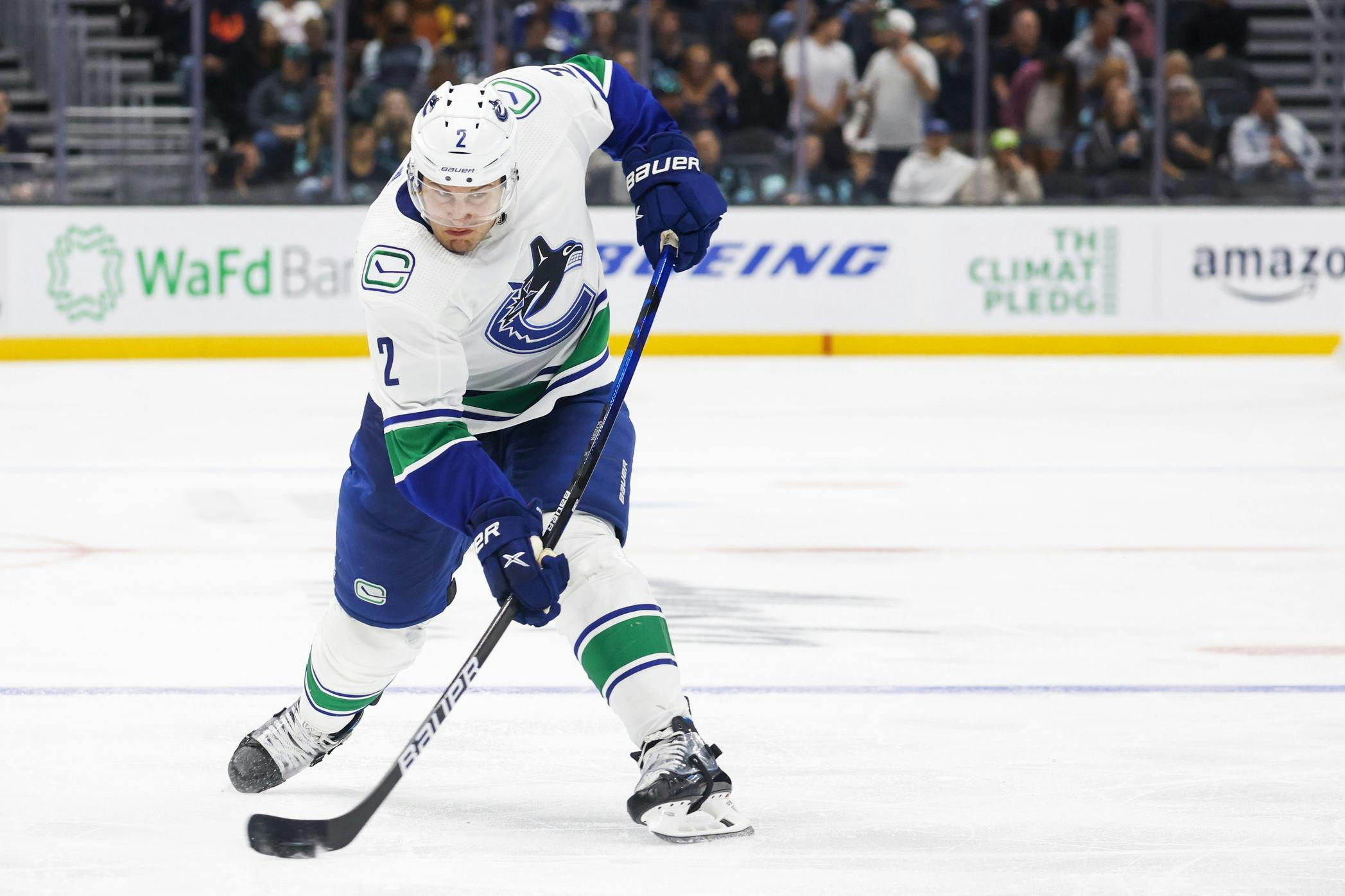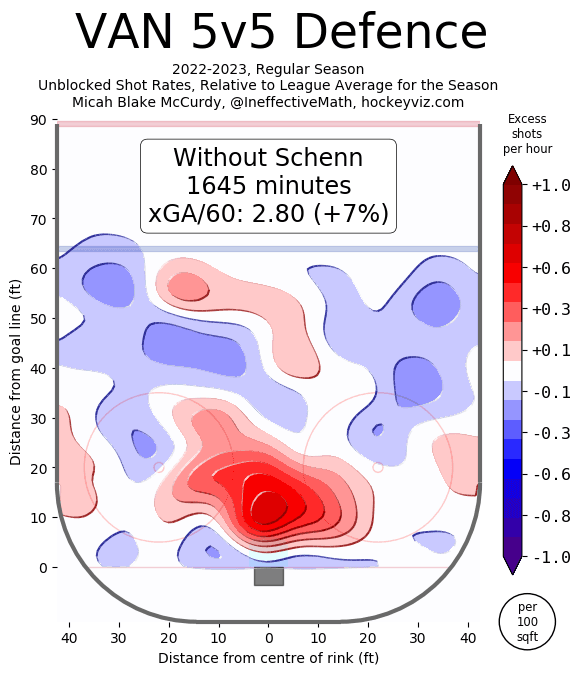Nation Sites
The Nation Network
FlamesNation has no direct affiliation to the Calgary Flames, Calgary Sports and Entertainment, NHL, or NHLPA
Luke Schenn could be a viable trade target for the Calgary Flames — provided he doesn’t cost much

Photo credit: Joe Nicholson-USA TODAY Sports
Feb 5, 2023, 13:45 ESTUpdated: Feb 5, 2023, 21:43 EST
The trade deadline is coming up and the Flames are very much in the thick of the playoff race. They may be just outside a wild card spot, but they’re still hanging around.
One of the players circling the rumour mill in terms of a possible Flames acquisition is current Vancouver Canucks defenceman — and two-time Stanley Cup champion — Luke Schenn.
Let’s examine how he’s played this season, how he has performed in the past, and whether or not he could be a fit in Calgary.
This season
Hockeyviz.com has heatmaps that let us see how the team performs with a player on the ice and without a player on the ice. Let’s see how Vancouver is affected by Schenn.


Ideally, in these graphics, an effective defensive player will have a negative percentage impact. The higher the positive number the more cumulative quality the player gives up while on the ice — the more the number is in the negatives, the better they help suppress chances.
The Canucks, as a whole, suppress chances at a worse rate with Schenn on the ice compared to when he’s on the bench. Being a right-handed defenceman, you can see Schenn’s impact next to the net, but this raises questions about whether or not the player is struggling with breakouts.
How can we see what is happening with him when he’s on the ice? Let’s isolate his numbers and see his individual impact rather than the overall team impact.

This is a good way to show evidence in multiple ways that Schenn is very good next to the net, but hardly affects the play anywhere else on the ice. On the offensive side, he does nothing but direct low-percentage shots towards the net, which is not how Calgary likes to play.
The preference in Calgary is for the defence to put the puck back low or send it to the other defenceman – Schenn actively contributes negatively towards offence with how he has played. He’s done this throughout his career.
Previous years
There is going to be a boatload of Hockeyviz.com charts in here and that is a glowing endorsement from me. Micah Blake McCurdy produces fantastic content — some of the easiest graphs to read and understand.
Anyway, here are the offence and defence impacts from each and every year of Schenn’s long career:

Lots of people could use the “Vancouver is just bad” excuse to say Schenn’s impact is diminished — no disagreement here. That isn’t my concern.
Schenn’s defensive results can rise to fantastic heights — see his 2020–21 season in Tampa. There, he was on a strong team that plays a similar fast-paced smothering forecheck style of hockey to Calgary.
The problem I see — and it’s been consistently in his game for at least the last seven years — is Schenn kills offence. He constantly stalls momentum with his choices in the attacking zone, regardless of whether he’s playing on a cup contender or a bottom feeder. The Flames don’t need another offensively deficient player.
This is not to say Schenn isn’t useful or can’t help somebody. This limitation just makes him a more difficult fit to work in Calgary.
Historical precedent
Schenn would hardly be the first defenceman of his ilk to play for the Sutter-coached Flames in a third-pairing RD role.

Here is Erik Gudbranson the season before he came to Calgary, in which he played for Ottawa and Nashville. This is an eerily similar-looking profile to Schenn’s from this current season.
Let’s see what happened to Gudbranson under the influence of Darryl Sutter, Ryan Huska, and the Calgary Flames.

Gudbranson’s play around the crease got worse, but he was able to use the team attack approach and the strategies Calgary employs on offence to his advantage. He became a more effective offensive weapon at the cost of his defensive results.
In his own end, Gudbranson’s shortcomings were largely masked by the great play of Nikita Zadorov (who has been well worth every penny). Nevertheless, the Columbus Blue Jackets elected to give Gudbranson a hefty four-year deal that already looks like a buyout candidate.

A good team structure can help cure this, and using Gudbranson as an example clearly shows that. Lets post Stone’s career impacts and see what happened to him when Sutter took over from Geoff Ward.

Stone’s lack of game action from 2018–19 to 2021–22 necessitates more caution as in some of those seasons he didn’t play enough to create a statistically meaningful sample. He only barely reached that threshold in the 2019–20 season.
So let’s look at that impact vs. this season — it’s the best comparable we have thanks to sample size. Stone was one of the worst players in terms of defensive impact in the entire league when Sutter took over, now he’s just in the middle of the below-replacement-level group (although still contributing negatively to shot suppression).
The Flames’ pattern of changing offensive impact for defence holds true here — Stone went from just providing point shots to melding with a more spread-out attack along the blue line. The visualization also shows a pattern of Stone improving his right side net-front defence.
With these examples, we can confidently state one thing: Darryl Sutter will improve the offensive impact of a defenceman branded as being a “defence-only” guy.
Now, only one question remains.
Is Luke Schenn a fit for the Flames?
Using Gudbranson as an example, there is no guarantee Schenn will improve upon his defensive numbers. The only thing we see across examples is the pattern that a defensive player’s impact in the offensive zone will improve in the Sutter system.
It’s pretty easy to pick out exactly what Schenn brings: net-front defence and shots from the point. The Flames don’t need any more low-percentage shooters but they do need to improve upon Stone’s defensive numbers.
With that being said, Schenn would likely be an upgrade on Stone in the defensive zone, but you would also lose the positive offensive contributions Stone brings from the point.
This Flames team does desperately need injury insurance but they also don’t need to be trading quality assets for depth. I saw earlier in the year Schenn’s agent said he was worth a first-round pick. That’s laughable.
My Take: There isn’t much out there in terms of rental defencemen who can play every day. If Calgary makes a trade to improve their offence by adding a forward, they may be able to absorb the drop in offence that Schenn brings with him everywhere he goes.
Calgary has primarily struggled in two areas this season: scoring goals and letting in weak ones. Schenn doesn’t score much and he can’t do much to prevent his goaltenders from giving up stinkers. Even with the effect the Flames system would have on his offence, it’s still no guarantee Schenn ends up on the positive side in that area. It’d be fine to add him as depth, but the acquisition cost needs to reflect the role he would most likely play.
Schenn for a fourth-round pick? I would do that trade all day. For a second-round pick? Not a wise use of future assets.
Breaking News
- Flames Prospect Roundup: Jacob Battaglia had a four-point night
- NHL Notebook: Sabres fire general manager Kevyn Adams
- Beyond the Boxscore: Flames extinguished by Celebrini magic in 6-3 loss to the Sharks
- 3 predictions for the rest of the Flames season
- Report: The Flames have received plenty of calls about Rasmus Andersson since the Quinn Hughes trade
